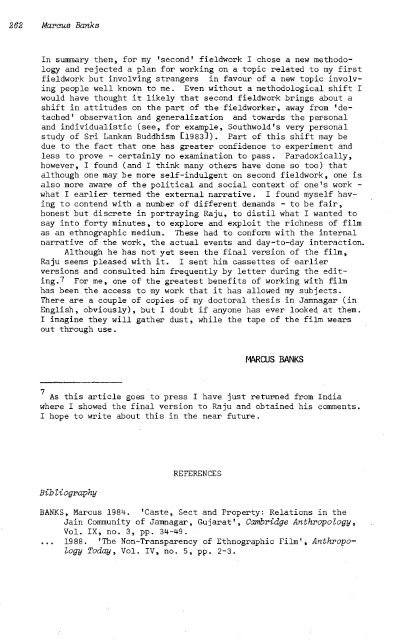CONTENTS NO.I - Institute of Social and Cultural Anthropology ...
CONTENTS NO.I - Institute of Social and Cultural Anthropology ...
CONTENTS NO.I - Institute of Social and Cultural Anthropology ...
Create successful ePaper yourself
Turn your PDF publications into a flip-book with our unique Google optimized e-Paper software.
262 MarCU8 Bank8<br />
In summary then, for my 'second' fieldwork I chose a new methodology<br />
<strong>and</strong> rejected a plan for working on a topic related to my first<br />
fieldwork but involving strangers in favour <strong>of</strong> a new topic involving<br />
people well known to me. Even without a methodological shift I<br />
would have thought it likely that second fieldwork brings about a<br />
shift in attitudes on the part <strong>of</strong> the fieldworker, away from 'detached'<br />
observation <strong>and</strong> generalization <strong>and</strong> towards the personal<br />
<strong>and</strong> individualistic (see, for example, Southwold's very personal<br />
study <strong>of</strong> Sri Lankan Buddhism [1983]). Part <strong>of</strong> this shift may be<br />
due to the fact that one has greater confidence to experiment <strong>and</strong><br />
less to prove - certainly no examination to pass. Paradoxically,<br />
however, I found (<strong>and</strong> I think many others have done so too) that<br />
although one may be more self-indulgent on second fieldwork, one is<br />
also more aware <strong>of</strong> the political <strong>and</strong> social context <strong>of</strong> one's work -<br />
what I earlier termed the external narrative. I found myself having<br />
to contend with a number <strong>of</strong> different dem<strong>and</strong>s - to be fair,<br />
honest but discrete in portraying Raju, to distil what I wanted to<br />
say into forty minutes, to explore <strong>and</strong> exploit the richness <strong>of</strong> film<br />
as an ethnographic medium. These had to conform with the internal<br />
narrative <strong>of</strong> the work, the actual events <strong>and</strong> day-to-day interaction.<br />
Although he has not yet seen the final version <strong>of</strong> the film,<br />
Raju seems pleased with it. I sent him cassettes <strong>of</strong> earlier<br />
versions <strong>and</strong> consulted him frequently by letter during the editing.7<br />
For me, one <strong>of</strong> the greatest benefits <strong>of</strong> working with film<br />
has been the access to my work that it has allowed my subjects.<br />
There are a couple <strong>of</strong> copies <strong>of</strong> my doctoral thesis in Jamnagar (in<br />
English, obviously), but I doubt if anyone has ever looked at them.<br />
I imagine they will gather dust, while the tape <strong>of</strong> the film wears<br />
out through use.<br />
MARCUS BANKS<br />
7 As this article goes -to press I have just retupned from India<br />
where I showed the final version to Raju <strong>and</strong> obtained his comments.<br />
I hope to write about this in the near future.<br />
Bibliography<br />
REFERENCES<br />
BANKS, Marcus 1984. 'Caste, Sect <strong>and</strong> Property: Relations in the<br />
Jain Community <strong>of</strong> Jamnagar, Gujarat' , Cambridge <strong>Anthropology</strong>,<br />
Vol. IX, no. 3, pp. 34-49.<br />
1988. 'The Non-Transparency <strong>of</strong> Ethnographic Film', <strong>Anthropology</strong><br />
Today, Vol. IV, no. 5, pp. 2-3.

















